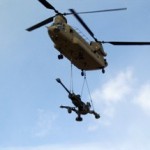

Photo Courtesy of U.S. Army
A CH-47 Chinook helicopter airlifts a 155 mm howitzer onto Forward Operating Base Shank, Afghanistan, while being protected from the threat of enemy shoulder launched missiles due to the Common Missile Warning System (CMWS).
By Brandon Pollachek, PEO IEW&S Public Affairs Officer
In a New Hampshire industrial plant, far away from the battlefields of Iraq and Afghanistan, a system that has provided soldiers with a great amount of protection reached its original Acquisition Program Objective (APO) on April 30.
The Army accepted the delivery of the1,710th Common Missile Warning System (CMWS) approximately one year ahead of schedule from BAE.
With CMWS systems installed on almost all Army aircraft in the combat zone, pilots flying missions in Operation Enduring Freedom and Operation Iraqi Freedom have been afforded a sense of security, which was not available to them prior to the devices inclusion as a part of the aircraft survivability equipment on-board. The rate of aircraft crashing due to enemy shoulder launched missiles decreased as quickly as the systems were introduced into theater.
The systems, managed by Project Director Aircraft Survivability Equipment (PD ASE), were fielded to aviation units on an accelerated timetable. Following the loss of a CH-47 Chinook helicopter to an enemy missile in November 2003, then Acting Secretary of the Army, R.L. Brownlee called for a plan, “… to equip all our helicopters in Iraq and Afghanistan with the most effective systems we have in development or procurement.”
In response to Brownlee’s direction, less than a year later, the first CMWS system was installed and now pilots are provided with persistent protection from the threat of Man Portable Air Defense Missile (MANPADS), which proliferated the battlefield in the early phase of OEF and OIF.
“The Army is committed to ensuring Soldiers are fully equipped to perform their missions and have the best force protection capabilities possible,” said BG Thomas Cole, Program Executive Officer Intelligence, Electronics Warfare & Sensors (PEO IEW&S). “CMWS has proven to be a game changing system allowing aircraft to move throughout theater in a much safer manner. Whether providing close air support, transporting troops or conducting medical evacuations the CMWS has improved our effectiveness in all areas.”
In addition to improved safety figures, Army aviators are finding CMWS allows them to neutralize potential threats.
“The bad guys are finding out the hard way that shooting a missile at army aircraft is a lose-lose situation for them. They have an extremely low probability of a hit, and due to the CMWS and similar systems, they also have a high probability being detected and destroyed after the shot,” said CWO (5) Pat Shores, a UH 60 pilot who flew with the 4th Infantry Division during OIF.
Plans are for the APO to be extended as requests for the systems continue to come in. CMWS is currently in the early stages of partnering with the Advanced Threat Infrared Countermeasures (ATRICM) to continue to advance the protection envelope for Army aircraft and crews.
In celebration of the 25th anniversary of the Army Acquisition Corps (AAC), Access is publishing articles that highlight milestones throughout the history of the AAC. Each article marks a moment in acquisition excellence.







